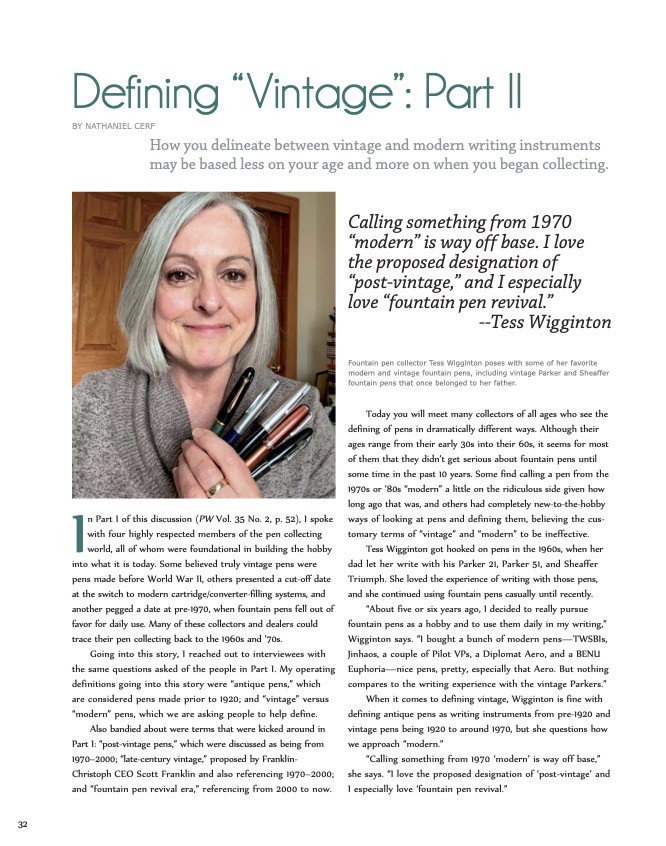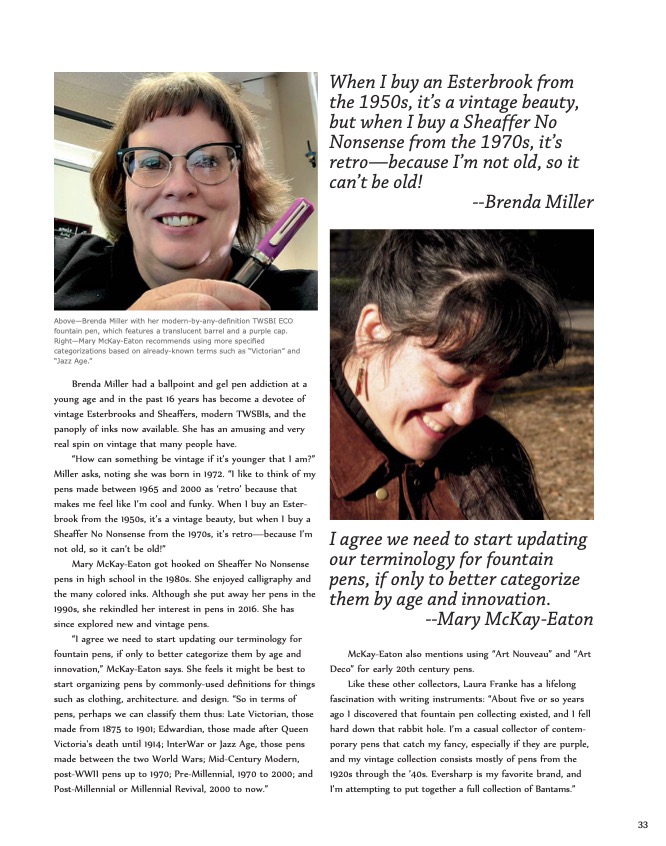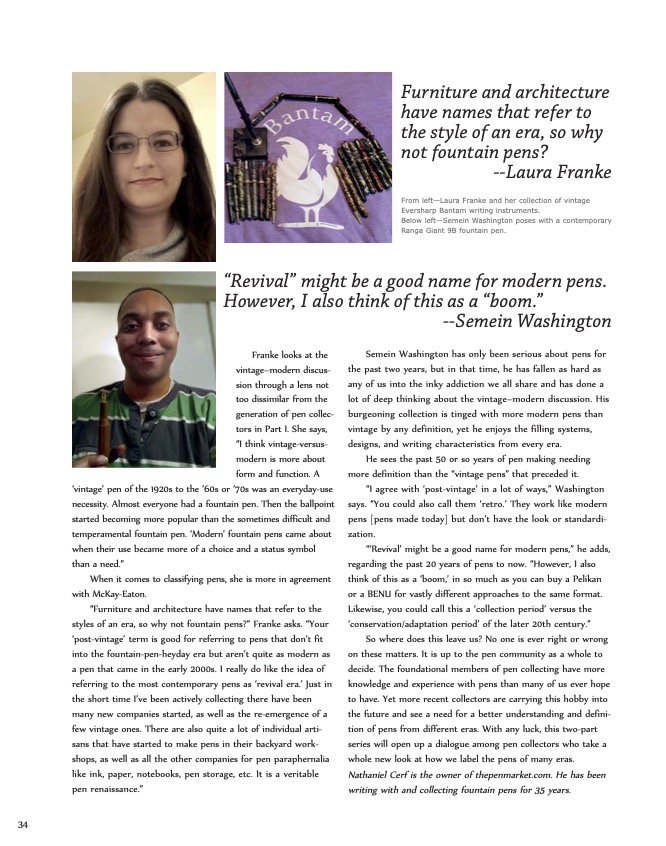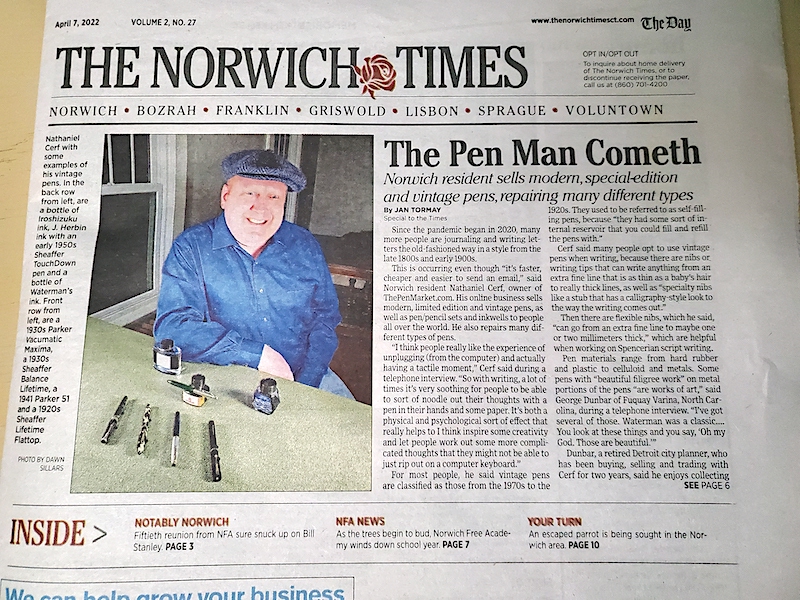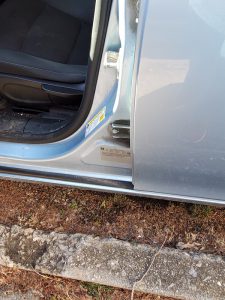The sequel to my story in Pen World Magazine is now on news stands. Click each photo to read each page of the story. We have permission to reprint it here from Pen World editor Nicky Pessaroff. Be sure to subscribe to Pen World to read this and many other great stories about pens.

Monthly Archives: April 2022
Front Page News
News about ThePenMarket.com is spreading. I was lucky enough to be honored by a front-page feature in The Norwich Times! We’ve been featured before in “Pen World” magazine. However, I think this is our first time in a newspaper. Check it out: https://www.theday.com/local-news/20220406/norwich-resident-specializes-in-modern-vintage-pens
How Do I Buy a Used Car?
Spring is here, and, traditionally, this is a time many people start looking for a car. The Covid pandemic has limited the number of new cars on the market, and many people are turning to used cars to replace their set of wheels.
Buying a used car can be a stressful experience, especially now when used cars are selling at extremely high prices. As such, I thought I’d try to help you navigate these challenges.
I can already hear you. “Wait, Nathaniel. This is a pen blog. What do you know about used cars?”
As fate would have it, my first job out of college was as a salesman for a national chain of used car dealerships. Part of our training was to prove how our cars were better than other dealerships’ cars. And so, we were trained to spot damage in a used car and the possible ways other dealers might fleece people on financing. The following information has saved me and my friends a lot of money and heartache over the years. Hopefully, it will help you, too.
Knowledge is power, and it is best to power-up before you start shopping in earnest. If you know it is time to replace your old ride, start taking a closer look at the cars you see on your daily commute and in the parking lots you frequent to get an idea of what you like. Also keep in mind what you need the vehicle for. You might want a two-door Porsche, but if you have a family of five, you’re gonna need something bigger with trunk space. As we go into a new cycle of high gas prices, seriously consider what type of mileage this vehicle can get. As gas toys with $5-a-gallon, that bad-ass SUV you love that gets 12 miles per gallon might give way to a Toyota Prius that gets 40mpg. As you narrow in on a couple models that you like, research their common problems and pricing. Every car has a weak spot. For example: Subarus frequently have problems with their head gaskets. Chevy Cruze sedans are notorious for blowing out their original factory turbo-chargers. Check to see if these problems have been fixed in the car you ultimately buy. Most models of cars have a fan website where you can ask other owners about mechanical issues. Plus, Kelly Blue Book (kbb.com) has up-to-date pricing for every year, make and model of car at different mileage and trim levels. Don’t let old stereotypes hold you back. It used to be everyone thought American cars were untrustworthy and Japanese cars were built to last forever. Well, American quality control has gone up and Japanese quality control has seen a dip. It really is best to research the year, make, model and trim line you are interested in to make sure you are getting what you want.
Searching the internet makes it so much easier to locate a car you want. Google “used Honda Accords near (your zip code)” and you’ll likely get every Accord available in a 20 or 30-mile radius. This makes it easy to do some simple comparison shopping. Prices, mileage, colors, etc. Yet, there are many other variables to consider. A certified Ford F-150 from a Ford dealership might be a little more expensive, but it might also come with guarantees that “Crazy Bob’s Used Truck Emporium” might not have. Some dealerships guarantee that all of the maintenance is up to date and even give you a limited warranty to make sure all is as they promised. Others don’t. Get every dealer’s guarantee in writing before you take the plunge. Some smaller dealerships don’t offer any guarantees, but this does not automatically mean they are bad or untrustworthy. If you know what to look for, often you can save hundreds on a vehicle from a mom-and-pop dealership. BUUUUT, if the deal looks too good to be true, definitely take a closer look. Also check to see which dealers negotiate a price. Some certified places don’t negotiate and some do. Most smaller dealerships are all about negotiating.
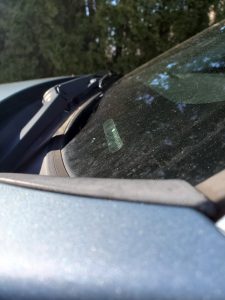
Vehicle Identification Number. Every car has one, and they are always located on the driverside front dash under the windshield.
Once you’ve narrowed your list down to two or three vehicles, it is time to go see them in person. Bring any and all the notes you want with you, and bring something to take notes with. Used car salesmen certainly have a stereotypical reputation, but not everyone is like that. As a former car salesman, I humbly request you be respectful and courteous until they give you a reason not to be.
A visual inspection of the vehicle is critical. One of the ways to make a ton of money on a used car is to take a wreck for scrap metal pricing and make it look close to new for $2,000 to $5,000. As many used cars these days are selling for $15,000 to $20,000, it is easy to see the incentive to do this. Unfortunately, the safety features and structural integrity of the car are ruined, and another crash could easily kill its occupants.
Take notes on all of the chips in the paint (road rash), especially on the front bumper, grill and hood. Look for door dings, etc. It is illegal in many states to sell a car with a cracked windshield, so keep an eye open for that, too. That’s the easy stuff, and although you might be able to save a little money on the cosmetic damage, it might also be a good indicator that the car has never been in a serious wreck.
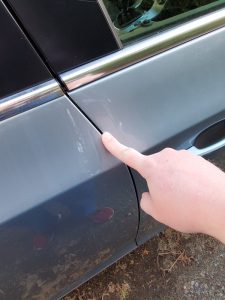
Run your finger over the seams between panels of your car’s exterior. Are they evenly spaced between panels? Is the paint smooth or bumpy?
Does the paint look uniform around the vehicle? In the right light (more often on a cloudy day), you can see where a couple doors on one side or the back bumper and trunk look a little lighter or darker than the rest of the car. If you can see three or more connected discolored panels, odds are good the car was in a serious wreck. Run your fingers along the seams between all of the exterior panels of the car. Does the seam get wide then narrow or vice versa? Seams from a factory-fresh car are uniform and don’t get narrow or wide at points. Non-uniform seams are an indicator that the panels have been removed and/or replaced and put back together. ALSO, as you run your finger over every seam, does the paint start to feel bumpy or lumpy. This is another great indicator that the panel was repainted. A factory paint job is universally smooth and perfect—no bumps or lumps.
Open all of the doors, hood and trunk at once. On every compartment of the vehicle there should be factory installed stickers with the V.I.N. (Vehicle Identification Number). Technically, a body shop should order and replace those stickers after a repair job, but virtually none of them do. If vehicle stickers are missing, then the odds are good that panel was replaced…an indicator of a car crash.
Regarding VIN numbers, many dealerships now give VIN reports to let you know if the car was ever listed as stolen, in an accident, in a flood or otherwise seriously damaged. Unfortunately, a clean VIN report does not guarantee the vehicle has never been in an accident. Although most states legally mandate body shops report serious damage on a VIN, many shops never report the damage to the state. You also can use the VIN to check the maintenance records. Say you are at Murphy van Mufflerson’s Used Car Lot and are looking at a Jeep. You can write down the Jeep’s VIN and then call a local Jeep dealer for the maintenance records. If Jeep/Chrysler serviced the vehicle, it will have all of the records of the service and recalls it performed on the vehicle anywhere in the country.
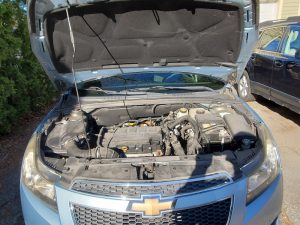
You can see the paint on all sides of the hood and along the panels matches. Plus, you can see the stickers are present and the welds are small and smooth. Plus, there are no leaks visible in the engine.
Also look to see if the paint on the outside of the panel matches the inside. If it doesn’t match, the panel was repainted at the very least. For example, a replacement hood might look like your car’s color on top but black or a different color underneath. A factory-original hood is painted the same color uniformly on top and bottom.
Another important thing to look for are the welds. Factory welds are very small, clean and precise. Sometimes a body shop will leave huge messy welds to fill holes or reattach badly mangled and straightened parts.
One last thing to look for are the bolts that hold the vehicle together. There is no reason the bolts should ever be undone for routine maintenance. If you can see where the bolt has stripped the paint from two panel pieces it is holding together and is maybe wearing through the metal, that is a clear sign of a problem and a likely indicator that those panels had to be removed to fix something from an accident. Even if a car is 40 or 50 years old, those bolts should be still be in place from when it was first built.
How are the tires? You should have enough tread that if you stick a penny head-first in the tread lines. Lincoln’s head should start to be covered by the remaining rubber of the tire. If his head is completely visible while in the tread, the tire is bald and needs to be replaced. Also look to see if one side of the tire is more worn on one side or in the middle. At the least, heavy wear on one side of a tire means the car is out of alignment. Yet, it could be an indicator that frame is bent or there is some other problem. Usually, the car just needs an alignment, but it is important to know for the future health and wellbeing of the vehicle.
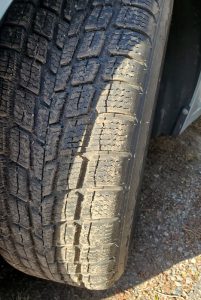
This is a new tire with deep tread, but you should always check to see if there is enough tread and even wear on the tire on your own car, as well as one you are looking to buy.
If you don’t mind getting dirty, get on the ground and look at the frame of the vehicle. If a frame was badly bent and then straightened, you will see big clamp or teeth marks in the frame rails near the tires. They won’t look natural to the construction of the vehicle. If you see these, stop what you are doing and do not buy the car. Every manufacturer designs a frame to have various tolerances for safety in a collision. If a frame is bent and then straightened, the metal fatigue in the frame guarantees the car will not be safe if you get in an accident. The metal fatigue also can create other problems in the wear and operation of the vehicle.
If you like what you see so far, it is time to take a closer look at the interior. Start with the trunk and pull up all of the carpeting in the trunk until you can see bare metal. Look for bad welds, but also look for mud, leaves and water damage. Smell for mold. It is illegal to sell a flood damaged vehicle in most states, but every hurricane season and flood season still finds flooded out cars heading to markets in other states. Most people who sell flood-damaged cars are good about cleaning all of the upholstery and engine compartment, but they frequently overlook the trunk compartment under the carpeting. If flood water gets into a vehicle’s engine, the engine will be shot within short order.
While you are in the trunk, check the spare tire, assuming this car still comes with a spare tire and jack, or for the tire repair kit.
Sit in all of the seats to see how the car feels for every passenger and play with all of the features in every seat position. It is better to find out before you buy the car that everything is working as it should. Sometimes things get overlooked at even the certified used car dealers and they’ll fix the problem before you buy the vehicle. Broken features also help you reduce the price for dealers that don’t fix the broken things.
Close up the vehicle, sit in the driver seat and make sure everything works. Even if it is a 100-degree day, turn on the heater to make sure it is working. Do the same in winter for the air conditioning. You can hear the condenser motor turn on, even if you can’t feel the difference between the cold air outside and inside. Check the radio and speakers, but don’t leave them on.
When you take a test drive, make sure the radio is off, so you can listen for any and all problems. Roll the windows up, at least for a little while, to just listen as you drive. You can even politely ask the salesperson with you to be quiet for a minute. Have any rattles or not-normal sounds checked out.
Even if a car sits unused for as little as a week, the brakes start rusting. This is okay. At the start of the drive, braking might sound pretty awful. Don’t worry about that. However, if the sound doesn’t go away in 5 or 10 minutes worth of driving, the car might need new brakes. It would be worth having them checked by a technician before buying the car.
As I am not a mechanic, I don’t know what to tell you to look for on the engine and transmission. When the hood was up, if you see an obvious leak, that is a bad sign. Otherwise, it is always wise to have your trusted mechanic give the car an inspection just to make sure all of the systems are in good shape. Most mechanics will offer this type of service for $50 to $100. Yet, a long-time family mechanic will often do this for free if he or she knows you well and knows you’ll be bringing them the car for maintenance over the years.
Are you ready to buy?
Your pricing research from earlier will help immensely. If you can point to a website with accurate pricing for exactly what you’re looking for, it is hard for the dealership to argue with that price. Use your notes about the cosmetic flaws or defects you want repaired to help you. There’s a little grey area depending on what extra features their car might have or their service might account for in terms of maintenance and warranty, but you should be able to hold them to a competitive price or walk away from the deal. When you start to walk away, count in your head how long it takes for the salesperson or their manager to come running after you. If your idea for a price is in the ballpark, they won’t let you get far.
Yet, even after you’ve agreed to a price, you aren’t free and clear, yet.
If you have a trade-in, be ready to negotiate that price as well. You can get the most out of your old car by selling it yourself, but most of us don’t want to deal with the hassle. Kelly Blue Book has a helpful tool to let you know the reasonable trade-in values for your old vehicle compared to the retail values.
If you have to finance the vehicle, it is important to know your credit rating going into the deal. Dealerships don’t just make money on the vehicle. They also make money on the financing. When the salesperson hands you off to the finance person, the finance guy gets paid bonuses by how high a percentage rate he (or she) thinks he can get out of you. Used cars have loan rates that are higher than new cars no matter who you go to. The best rates typically go to people who are in credit unions. Check your credit union or bank’s rates for a used car loan before you get a rate from the dealer. If you have good credit, and the bank thinks it can get you a 5.9% interest rate, take that information with you to the dealership.
Once you have the trade-in figured out, the finance person will put your info in the system and come back to you within seconds with a loan offer. Often they don’t share their screen with all of the loan offers with you. Usually they have a screen/computer in a separate back office they must consult. If you have good credit, maybe you’ll hear this: “Great news! You’re approved! We can get you in a 7.9% loan with a payment of $250 a month for 60 months.”
This is where the slope gets especially slippery. Loan rates go down depending on how much you borrow over a shorter amount of time. Finance people try to rope you into a payment amount more than an interest rate. If you want a $75 a month car payment, they’ll gladly sell you a loan with a 25% interest rate spread over 1,200 months. You think you’re getting a great deal because the monthly payment is so low, but you’re paying 25% interest over the next 100 years.
As used cars likely won’t live forever, you want to keep your repayment plan as short as you can afford. Plus, the shorter you go, the lower the interest will be. If you can afford a monthly payment that pays off the vehicle in 24 months or 36 months, that’s ideal.
If you know your credit rating, you can laugh at the higher interest rate and show the finance person your offer from your own bank. Sometimes you can play the two off each other. “If you can beat a 5.9% interest rate on a 36-month loan, you’ve got a deal.” Then they go back to their back room and see what they can work out. Maybe they had a 4.9% interest rate all along they could sell you. Maybe they can’t beat your bank’s rate. It’s often a 50/50 split whether a dealer can beat your financial institution. However, the finance person doesn’t make his or her bonus if he or she can’t get you into one of their loans, and they’ll move mountains to try to get you as good a deal if not better…BUT, you have to know your credit rating and bank’s rates first. Otherwise, you’re at their mercy.
There’s one last thing to keep in mind with buying a used car: an extended warranty. It is really worth reading the fine print of a dealership’s extended warranty offer. Cars that are only a year or two old sometimes still come with their original factory warranty. And most manufacturers now offer more than the old standard 3 years/36,000 miles, whichever comes first. Most manufacturers are offering up to 10 years/100,000 on the powertrain (engine/transmission). The trick is you only still get 3 years/36k miles for all the other systems. If a dealership’s used car extended warranty offers comprehensive coverage of parts and labor anywhere in the country, it might be worth it if the car is near the end of its factory warranty and you plan to keep it for a while. Yet, if the list of parts and systems not covered is longer than the list of things covered, or you only plan to keep the car for a year or two, it is likely a waste of money.


 Shopping Cart
Shopping Cart



